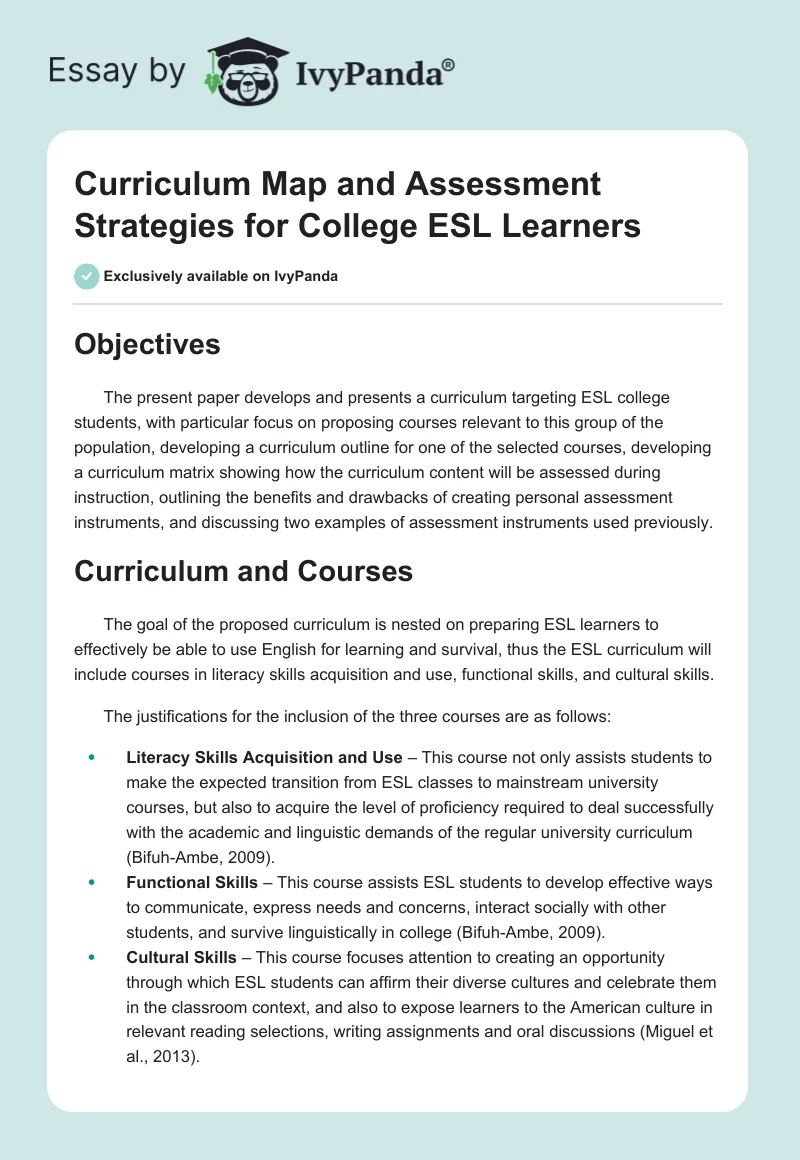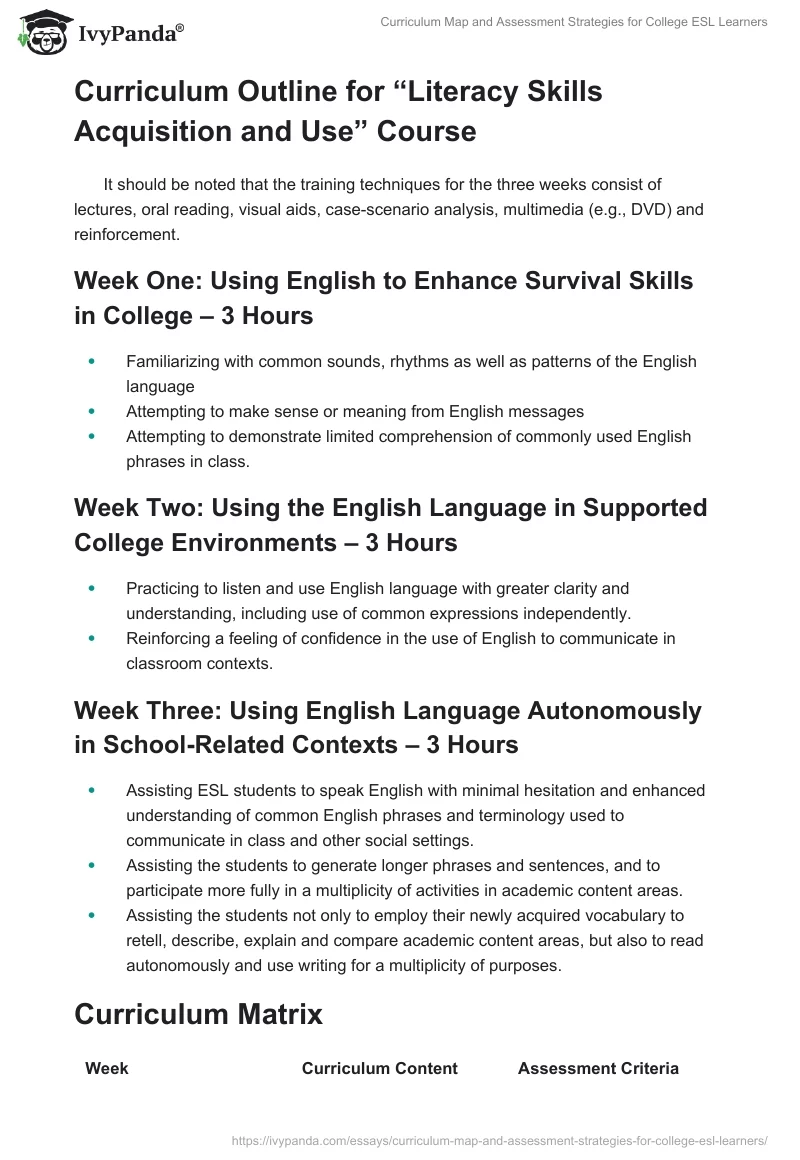Objectives
The present paper develops and presents a curriculum targeting ESL college students, with particular focus on proposing courses relevant to this group of the population, developing a curriculum outline for one of the selected courses, developing a curriculum matrix showing how the curriculum content will be assessed during instruction, outlining the benefits and drawbacks of creating personal assessment instruments and discussing two examples of assessment instruments used previously.
Curriculum and Courses
The goal of the proposed curriculum is nested on preparing ESL learners to effectively be able to use English for learning and survival, thus the ESL curriculum will include courses in literacy skills acquisition and use, functional skills, and cultural skills.
The justifications for the inclusion of the three courses are as follows:
- Literacy Skills Acquisition and Use – This course not only assists students to make the expected transition from ESL classes to mainstream university courses but also to acquire the level of proficiency required to deal successfully with the academic and linguistic demands of the regular university curriculum (Bifuh-Ambe, 2009).
- Functional Skills – This course assists ESL students to develop effective ways to communicate, express needs and concerns, interact socially with other students, and survive linguistically in college (Bifuh-Ambe, 2009).
- Cultural Skills – This course focuses attention to creating an opportunity through which ESL students can affirm their diverse cultures and celebrate them in the classroom context, and also to expose learners to the American culture in relevant reading selections, writing assignments, and oral discussions (Miguel et al., 2013).
Curriculum Outline for “Literacy Skills Acquisition and Use” Course
It should be noted that the training techniques for the three weeks consist of lectures, oral reading, visual aids, case-scenario analysis, multimedia (e.g., DVD), and reinforcement.
Week One: Using English to Enhance Survival Skills in College – 3 Hours
- Familiarizing with common sounds, rhythms as well as patterns of the English language
- Attempting to make sense or meaning from English messages
- Attempting to demonstrate limited comprehension of commonly used English phrases in class.
Week Two: Using the English Language in Supported College Environments – 3 Hours
- Practicing to listen and using English language with greater clarity and understanding, including use of common expressions independently.
- Reinforcing a feeling of confidence in the use of English to communicate in classroom contexts.
Week Three: Using English Language Autonomously in School-Related Contexts – 3 Hours
- Assisting ESL students to speak English with minimal hesitation and enhanced understanding of common English phrases and terminology used to communicate in class and other social settings.
- Assisting the students to generate longer phrases and sentences, and to participate more fully in a multiplicity of activities in academic content areas.
- Assisting the students not only to employ their newly acquired vocabulary to retell, describe, explain, and compare academic content areas, but also to read autonomously and use writing for a multiplicity of purposes.
Curriculum Matrix
Benefits & Drawbacks of Developing Own Assessment Instruments
Extant literature demonstrates that student assessment plays a fundamental and essential role in teaching and learning for ESL students, hence the need for instructors to devote a large portion of their preparation time to creating own assessment instruments (Cheng et al., 2004).
A personal assessment instrument, according to these researchers, is advantageous in ESL context as it has the capacity to elicit the most information per minute of assessment time since the instructor has prior knowledge of the students.
Additionally, a personal-based assessment instrument can be of immense importance when it comes to motivating students and exploring students’ organization of knowledge by virtue of the fact that it is developed based on the presenting needs and concerns of students (British Columbia, 1999).
Among the drawbacks, personal assessment instruments may not be very efficient in situations where time is limited, not mentioning that it may take a lot of time and skill to prepare items, leading to a scenario whereby such instruments may be incapable of assessing critical skills as effectively as other standardized instruments (Crusan, 2002).
Examples of Assessment Instruments
“ESL Oral Assessment Instrument”
“Analytic Oral Language Scoring Rubric”
References
Bifuh-Ambe, E. (2009). Literacy skills acquisition and use: A study of an English language learner in a U.S. university context. Adult Basic Education and Literacy Journal, 3(1), 24-33.
British Columbia. (1999). English as a second language learners: A guide for ESL specialists. Web.
Cheng, L., Rogers, T., & Hu, H. (2004). ESL/EFL instructors’ classroom assessment practices: Purposes, methods, and procedures. Language Testing, 21(3), 360-369.
Crusan, D. (2002), An assessment of ESL writing placement assessment. Assessing Writing, 8(1), 17-33.
Miguel, C.S., Townsend, L., & Waters, C. (2013). Redesigning nursing tutorials for ESL students: A pilot study. Contemporary Nurse, 44(1), 21-31.


